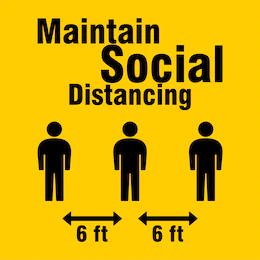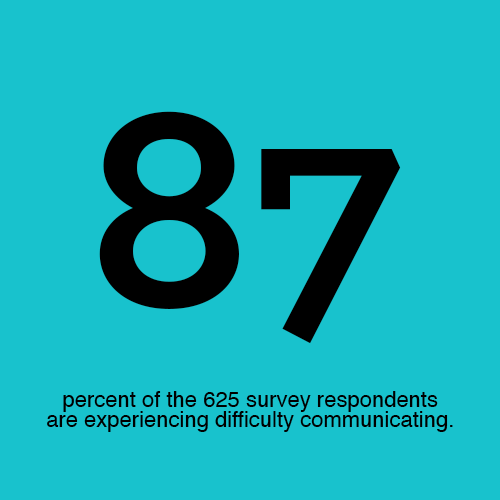By Yishane Lee
Being able to hear from a distance of at least six feet and while the speaker is covering the bottom half of their face has been daunting, to say the least, for people with hearing loss.
Frequent, proper handwashing, hand sanitizer use, and not touching your face were the early health and safety directives as the COVID-19 pandemic spread from country to country and then state to state. In the past few weeks, social distancing and face masks became the next tools in helping to stop the spread of the novel coronavirus.
Both are particular challenges for those with and without hearing challenges. In our recent questionnaire we asked how our Hearing Health Foundation community is handling these types of restrictions to face-to-face contact. We sent out a two-question survey asking about your challenges and advice for better communication during the pandemic.
Among the 625 responses, an overwhelming 87 percent are experiencing difficulty communicating. Within this group, 85 percent cite the inability to read lips as a problem.
Many added that being able to hear from a distance of at least six feet and while the speaker is covering the bottom half of their face has been daunting, to say the least. “Even hearing people seem to be having issues,” says one survey taker. Due to distance and masks, not being able to read lips or facial expressions puts everyone at a disadvantage. In addition, feeling isolated is already not uncommon among those with hearing loss, and the directive to shelter at home cuts off in-person connections.
Add to this the difficulty of fitting mask elastics, hearing devices, and maybe also glasses all in the limited real estate behind the ear—plus the stress of just staying safe and healthy in the midst of a highly transmissible, deadly disease—and what emerges is a perfect storm of issues for those with hearing conditions. Among respondents, 42 percent cited difficulty wearing their hearing aids or cochlear implant processors with a mask.
But our constituents are a resilient bunch, accustomed to both self-advocating as well as dealing with communication snafus. And while this is as we all know an unprecedented crisis affecting everyone around the globe, in their survey responses they detail the solutions they are putting to use.
Masks
“Instead of elastics behind the ears, I use a mask with ties. Some people wear a baseball cap and sew buttons near their ears. Instead of putting the elastic behind the ears, it is anchored to the buttons.”
“I attached the mask elastics to a wide elastic band I had that goes around the head. Also I put the ends of my eyeglass temples under the elastic band, so the only things on the ears are the hearing aids. Not perfect but workable.”
“I pull the mask out a little to speak more clearly and hope the person I’m speaking to will do the same.”
“Social distancing is still the best, and I think removing the mask to speak does not increase the risk drastically especially if done from afar.”
“I’ve found a face shield that I ordered is better than a mask, because it also covers your eyes and keeps you from touching your face, and protects others from any droplets. Plus it’s more comfortable because it doesn't scratch your face and keeps your face cooler.”
“Face masks with a clear portion or a face shield would work, but I would have to ask a stranger to wear them, and I'm thinking most would refuse because they don't know if it's sanitized and/or they have no experience with hard of hearing individuals and don’t understand why I am asking.”
“We continue to build a lending, portable ‘loop library’ so that people using telecoils can try them out in their personal settings. Our kit includes a Williams PLA90 personal loop plus a SoundTech external microphone. They are helping, at least somewhat, at home and for masked, ‘distanced’ book clubs, etc.”
Captioning
Speech-to-text smartphone and/or tablet apps like InnoCaption, Otter.ai, Live Transcribe, and TextHear. Users note that your phone mic may have difficulty picking up the speaker’s voice from six feet away, the apps may not work as well outdoors with ambient noise, and they likely need Wi-Fi for instant captioning.
At home, people are using captioned telephones and captioning services by established captioning companies such as CapTel, Hamilton CapTel, ClearCaptions, CaptionCall, and Sprint CapTel.
Video calls are useful so you can see faces: These include Zoom, Skype, FaceTime, and Google Meet. Google Meet, now offered for free, has live AI-generated transcriptions, as does Skype. FaceTime is useful for one-on-one conversations but also now has a group option. Note that ideally speakers take turns and the internet connection is strong to avoid freezing or a lag time.
“Second best to writing things down either on paper is using BuzzCards by Sorenson.” These are phrases you can set up on your phone to communicate, like flash cards, but it may require being closer than six feet to read.
Other tech
“Using more electronic communication like email or text.”
“To speak with my patients I use a remote mic attached to the Pocket Talker.”
“When my partner and I are out together while wearing our masks, he wears a Mini Mic that streams via Bluetooth into my hearing aids. It's a big help!”
“My Roger Pen.”
“I am using my Cochlear Mini Mic and Bluetooth phone clip more often to bring voice directly into my implants.”
No tech
“I keep busy at home. My anxiety skyrockets just thinking about going to town knowing everyone is wearing masks and I can't understand them.”
“I carry a notepad in my bag. if someone wants to tell me something and I can't understand, I ask them to write it down. I carry extra pens, so they can keep the pen if they want after they use it. I also suggest texting, even if we are within earshot.”
“I use my hand gestures and body language. Written communication on pen and paper is necessary. It is challenging to write on the paper when I wear gloves!”
“As always, I tell cashiers and masked people I have a hearing loss. 100 percent reply ‘no problem.’ That's an ironic reply to me as it's a huge problem, for me.”
“I have to remove my hearing aids whenever I wear a mask outdoors as they tend to get dislodged by the mask and I fear losing them.”
“I can't use the phone well, and I'm noticing a lot more phone usage being required (e.g., order online for pickup, then call when you're there for your order to be brought out). I wish texting was an option in these cases.”
“I have to ask for people to repeat many times and then I repeat what they say—sometimes leading to big laughs!!”
“I love online church services. The ministers stay in one location so I can hear them better. I play online bridge through text messaging. It’s sometimes better than actually live at a table with room noise from 12 more tables.”
“Patience and acceptance during this time of challenges.”
“SMILE! It can be seen in your eyes!”





